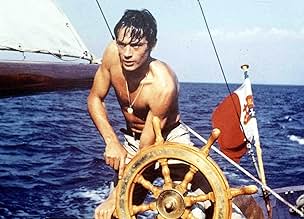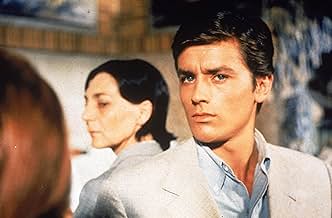AVALIAÇÃO DA IMDb
7,7/10
23 mil
SUA AVALIAÇÃO
Tom Ripley é um imitador talentoso, falsificador e improvisador criminal; mas Tom tem mais do que ele pode imaginar.Tom Ripley é um imitador talentoso, falsificador e improvisador criminal; mas Tom tem mais do que ele pode imaginar.Tom Ripley é um imitador talentoso, falsificador e improvisador criminal; mas Tom tem mais do que ele pode imaginar.
- Direção
- Roteiristas
- Artistas
- Prêmios
- 1 vitória no total
Marie Laforêt
- Marge Duval
- (as Marie Laforet)
Billy Kearns
- Freddy Miles
- (as Bill Kearns)
René Clément
- Le serveur maladroit
- (não creditado)
Walter Grant
- Bit
- (não creditado)
Paul Muller
- Blind Man
- (não creditado)
Jacqueline Parey
- Ingrid
- (não creditado)
Romy Schneider
- Freddy's companion
- (não creditado)
Avaliações em destaque
I found this film more interesting than the recent Minghella opus because the people were more disturbing.
Alain Delon is too good-looking to be dismissed as the geeky wannabee Matt Damon plays. His insanity in a pretty package is as unsettling as Gene Tierney's in "Leave Her to Heaven." Delon looks like Maurice Ronet's brother, and you can see him wonder why if he's just as handsome as the other guy, why doesn't he have as much money? Ronet is more unpredictable than Jude Law as the whimsical rich boy and his death is every bit as shocking.
I can't imagine that Anthony Minghella hadn't seen this version before making his own. He probably regrets Scorsese's reconstruction of Rene Clement's film so we can all make the comparison. Some scenes play like a shot-for-shot remake. Billy Kearns's brutal Freddy Miles is an obvious template for Philip Seymour Hoffman's more calculated and less powerful performance, and Gwyneth Paltrow's final breakdown is VERY close to that of Marie Laforet's.
All through the 1999 film, I kept wondering why everybody couldn't see what was wrong with the toad-like Damon. In this one, Delon's plausible, even glamorous exterior made the success of his deceptions more understandable, and more frightening.
Alain Delon is too good-looking to be dismissed as the geeky wannabee Matt Damon plays. His insanity in a pretty package is as unsettling as Gene Tierney's in "Leave Her to Heaven." Delon looks like Maurice Ronet's brother, and you can see him wonder why if he's just as handsome as the other guy, why doesn't he have as much money? Ronet is more unpredictable than Jude Law as the whimsical rich boy and his death is every bit as shocking.
I can't imagine that Anthony Minghella hadn't seen this version before making his own. He probably regrets Scorsese's reconstruction of Rene Clement's film so we can all make the comparison. Some scenes play like a shot-for-shot remake. Billy Kearns's brutal Freddy Miles is an obvious template for Philip Seymour Hoffman's more calculated and less powerful performance, and Gwyneth Paltrow's final breakdown is VERY close to that of Marie Laforet's.
All through the 1999 film, I kept wondering why everybody couldn't see what was wrong with the toad-like Damon. In this one, Delon's plausible, even glamorous exterior made the success of his deceptions more understandable, and more frightening.
Extremely well done, tightly edited, well acted (by everyone, including the small roles, especially the actor who has to appear dead with long camera shots in a tense scene in the hotel). Delon is perfectly cast, with his calculating cool.
The cinematography is gorgeous, especially the scenes on the yacht---nothing gimmicky, but shot with an expertise that gives true drama to the action. You can feel the waves, the wind, and the sun. The colors are vibrant on the DVD. Though a scene like this in a typical movie today would include a heavy ominous score, the director simply lets the sound of the wind create the tension. The score (by Nina Rota), in fact, is understated, unlike anything today. Even the opening credits have style.
The cinematography is gorgeous, especially the scenes on the yacht---nothing gimmicky, but shot with an expertise that gives true drama to the action. You can feel the waves, the wind, and the sun. The colors are vibrant on the DVD. Though a scene like this in a typical movie today would include a heavy ominous score, the director simply lets the sound of the wind create the tension. The score (by Nina Rota), in fact, is understated, unlike anything today. Even the opening credits have style.
Alain Delon and Maurice Ronnet play a fascinating duet of savage cruelty in this tense beautifully crafted Rene Clement thriller from Patricia Highsmith's pen. Anthony Minghella remade it as "The Talented Mr Ripley" with a more polished script and some startling character development but "Purple Noon" has an unbeatable extra gear in Alain Delon's portrayal. He is deadly because anyone would have fallen into his trap. His beauty is inviting and reassuring. We witness his brutal side but don't get to the point of judging him. That is more unique than rare in a movie. Delon's Ripley acts as if there was nothing objectionable about his behavior. A poster boy for amorality. Marie Laforet's Marge is stunningly beautiful but don't get to know her as well as we do Gyneth Paltrow in Minghella's version. If you liked The Talented Mr Ripley" you're going to love "Purple Noon" and vice-versa.
Purple Noon with Alain Delon, Maurice Ronet,and Marie Laforêt, is the chilling original to The Talented Mister Ripley. The blindingly beautiful Mediterranean background serves as a stark contrast to the lives of three spoiled and amoral characters on holiday in Italy. This original of The Talented Mr. Ripley is far different from the more recent movie, with Delon being more believable as Tom Ripley, his unbelievably handsome face hiding an evil mind, willing to do whatever it takes to trade places with Philippe Greenleaf.
There are some gratuitous shots here for 1960, and I wasn't real impressed with Maurice Ronet,who seemed too old for the part of Philippe, but on the whole, an enjoyable experience with great plot development and cinematography. The movie pulled you in like a day in the Riviera.
There are some gratuitous shots here for 1960, and I wasn't real impressed with Maurice Ronet,who seemed too old for the part of Philippe, but on the whole, an enjoyable experience with great plot development and cinematography. The movie pulled you in like a day in the Riviera.
I'm fascinated by a scene at a restaurant. We get an extreme close-up of a woman who is kept out of focus while another character in the background, who is speaking and is in the center of the shot, remains in focus. Is the woman who is out of focus important or not? More to the point, was shooting it this way a good idea? It illustrates by contrast how sure-footed René Clément is most of the time. Usually there can be no debate.
I wasn't familiar with Clément's work until this film, but my God, he's good. His camera is always in some unexpected place that enhances the drama and tightens the suspense. He shares that talent with Orson Welles (meaning the Welles of "Citizen Kane" and "The Magnificent Ambersons," not, say, "Lady from Shanghai"), who also made decisions that are surprising yet invariably right.
Tom Ripley (Alain Delon) and Phillipe Greenleaf (Maurice Ronet) are lately inseparable friends. They're both idling in Europe, but on papa Greenleaf's dime. Phillipe's fiancée Marge (Marie Laforêt) feels sorry for Tom but resents his presence. Phillipe's other friend, Freddie (Billy Kearns), considers Tom Ripley a worthless moocher. But there's more to Tom Ripley, the mimic, the forger, the talented criminal improviser, than anyone, even Tom Ripley himself, can guess.
Alain Delon, with his chiseled looks and cold beauty, makes an excellent Tom Ripley. The script is brilliantly adapted from Patricia Highsmith's terrific suspense novel, "The Talented Mr. Ripley": the dialogue is always bringing the themes of duplicity, love, self-love, the nature of identity, ruthlessness and murder to the surface where they are given a brilliant sheen by Clément and his cinematographer Henri Decaë.
We're left to figure things out for ourselves, which is rare. Do we need to be told what Tom thinks of when he sees all those dead fish? When a door with a mirror swings open toward Tom, do we need to see Tom's mirror image to understand the mirror's significance? Or is it enough that we know there's a mirror next to Tom? I know what the answers would have been in Hollywood—in 1960 and now. Here, the answers are no, no and yes.
I wasn't familiar with Clément's work until this film, but my God, he's good. His camera is always in some unexpected place that enhances the drama and tightens the suspense. He shares that talent with Orson Welles (meaning the Welles of "Citizen Kane" and "The Magnificent Ambersons," not, say, "Lady from Shanghai"), who also made decisions that are surprising yet invariably right.
Tom Ripley (Alain Delon) and Phillipe Greenleaf (Maurice Ronet) are lately inseparable friends. They're both idling in Europe, but on papa Greenleaf's dime. Phillipe's fiancée Marge (Marie Laforêt) feels sorry for Tom but resents his presence. Phillipe's other friend, Freddie (Billy Kearns), considers Tom Ripley a worthless moocher. But there's more to Tom Ripley, the mimic, the forger, the talented criminal improviser, than anyone, even Tom Ripley himself, can guess.
Alain Delon, with his chiseled looks and cold beauty, makes an excellent Tom Ripley. The script is brilliantly adapted from Patricia Highsmith's terrific suspense novel, "The Talented Mr. Ripley": the dialogue is always bringing the themes of duplicity, love, self-love, the nature of identity, ruthlessness and murder to the surface where they are given a brilliant sheen by Clément and his cinematographer Henri Decaë.
We're left to figure things out for ourselves, which is rare. Do we need to be told what Tom thinks of when he sees all those dead fish? When a door with a mirror swings open toward Tom, do we need to see Tom's mirror image to understand the mirror's significance? Or is it enough that we know there's a mirror next to Tom? I know what the answers would have been in Hollywood—in 1960 and now. Here, the answers are no, no and yes.
Alain Delon's Top 10 Films, Ranked
Alain Delon's Top 10 Films, Ranked
To celebrate the life and career of Alain Delon, the actor often credited with starring in some of the greatest European films of the 1960s and '70s, we rounded up his top 10 movies, ranked by IMDb fan ratings.
Você sabia?
- CuriosidadesAlain Delon's then girlfriend Romy Schneider appears in the very first scene as a friend of Freddie Miles.
- Erros de gravaçãoOnlookers are clearly visible in the background in the fish market scene.
- Citações
Philippe Greenleaf: That's why you took my bank statements?
Tom Ripley: Exactly.
Philippe Greenleaf: So you kill me and you're rich?
Tom Ripley: Don't miss a trick, do you?
Philippe Greenleaf: It seems awfully complicated. You'd be caught immediately.
Tom Ripley: No necessarily. I might not look it, but I've got lots of imagination.
- ConexõesEdited into Spisok korabley (2008)
Principais escolhas
Faça login para avaliar e ver a lista de recomendações personalizadas
- How long is Purple Noon?Fornecido pela Alexa
Detalhes
- Data de lançamento
- Países de origem
- Idiomas
- Também conhecido como
- A pleno sol
- Locações de filme
- Ischia Ponte, Ischia Island, Nápoles, Campânia, Itália(as Mongibello)
- Empresas de produção
- Consulte mais créditos da empresa na IMDbPro
Bilheteria
- Faturamento bruto mundial
- US$ 178.526
- Tempo de duração
- 1 h 58 min(118 min)
- Proporção
- 1.66 : 1
Contribua para esta página
Sugerir uma alteração ou adicionar conteúdo ausente

![Assistir a Trailer [English SUB]](https://m.media-amazon.com/images/M/MV5BYzkzMWVkMmEtM2I3Zi00MjE2LTkxZGYtZDYxMDFmMjBmMzM5XkEyXkFqcGdeQXRyYW5zY29kZS13b3JrZmxvdw@@._V1_QL75_UX500_CR0)



















